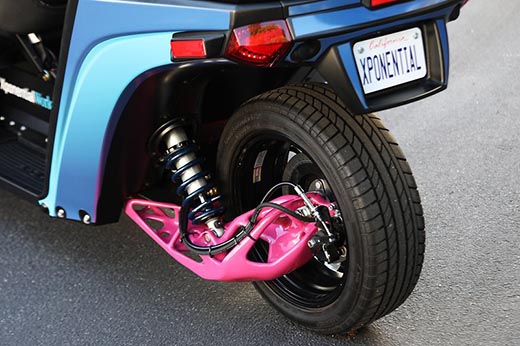Henkel and Nexa3D Sign Material Development Agreement for Next-Generation Functional Polymer
Press release from the issuing company

Next-generation polymers from Henkel and Nexa3D for industrial production: rear swing arm casting aluminum with 3D Printing pattern for Acimoto.
Extended partnership to accelerate the adoption of additive manufacturing and functional materials for industrial applications
Henkel and Nexa3D, the maker of ultrafast polymer 3D printers, today announced the signing of a new material development agreement. This agreement builds upon the companies’ partnership and deepens their joint commitment to advancing the capabilities of additive manufacturing (AM) for volume production. The two companies plan to develop next-generation functional polymers that leverage their combined technologies specifically targeting volume production opportunities in industrial casting, footwear, medical, and consumer goods industries.
As part of the expanding partnership, Henkel and Nexa3D are developing a new casting material designed for industrial metal castings suitable for applications such as automotive, robotics, heavy machinery, and hydraulics. Manufacturers can use the material to produce complex geometries to reduce weight and consolidate parts, resulting in affordable lightweight parts at high production volumes. The new class of functional material is fully optimized for ultrafast 3D printing workflows. Use of advanced design for additive manufacturing tools will further optimize results possible with the material, enabling reductions in material and energy consumption as well as final part weights and costs.
The combination of Nexa3D’s ultrafast additive production platform and Henkel’s development of a new generation of casting material can digitize the casting workflow of foundries looking to upgrade from traditional wax tooling to AM. This development delivers all the benefits of traditional metal AM, at much higher productivity using supply chain approved metals without compromising on quality.
Traditional manufacturing methods, such as using wax patterns, commonly require expensive tooling and refrigerated transport to maintain their shape during transport. This new casting material produces thermally stable patterns, eliminating the need for refrigerated containers or bespoke tooling for each design. The parts are also more sustainable, compared to traditional stereolithography processes, because they use fresh resin, rather than resin from a large vat that requires constant energy to maintain.
“In order to accelerate the adoption of additive manufacturing, we recognize that materials need to be customized for a given printer platform to meet the specific needs of the end user,” says Simon Mawson, Senior Vice President and Global Head of 3D Printing and Incubator Businesses at Henkel. “By entering into a formal material development agreement with Nexa3D, we can now leverage the power of Albert, our highly agile, proprietary, digital innovation platform, to unlock the full potential of the Loctite photopolymers portfolio and Nexa3D’s ultrafast additive production platform.”
“We have found that fewer than five percent of the more than 45,000 foundries globally currently use 3D printing, with adoption typically constrained by technology being either too slow or too expensive,” explained Kevin McAlea, COO of Nexa3D. “Compared to traditional stereolithography printers, the combination of this new material and our ultrafast technology offers 20X productivity and produces far more robust parts. Foundries and patternmakers now have access to a complete digital workflow that enables them to speed up production and post-processing to develop patterns faster.”
“Our extended partnership with Henkel also allows us to deliver new additive solutions to the market at a time when traditional supply chains are stretched and brittle. We’re not simply suggesting existing materials to customers — we are tailoring the material solution to suit our customers’ applications. For example, we are currently collaborating with Henkel on a new generation of ultrafast functional materials that improve modelling cycle time by orders of magnitude capabilities,” continued McAlea.
Henkel and Nexa3D have an established partnership that this year has already resulted in the introduction of a new class of medical device as well as a dedicated center for AM advancement. The 3D printed SKOP telemedicine stethoscope was created using biomimicry design concepts, color-matched materials, and complex geometries only possible via 3D printing. The SKOP arose from a collaboration among Nexa3D’s technology, Henkel’s materials, contract manufacturing from Third, and healthcare company WeMed. Nexa3D and Henkel further launched the NEXTFACTORY in Ventura, California this year as a full-scale AM customer center. The center offers customers access to integrated post-processing technologies, material formulation customization, color matching, and a variety of finishing options.
Following the launch of the new casting material, Henkel and Nexa3D will work toward further targeted formulations. Applications in healthcare, footwear manufacture, and consumer goods, for example, offer ample opportunity for next-generation functional materials and ultrafast 3D printing production capabilities.
To learn more about Henkel’s innovation in 3D printing visit www.LoctiteAM.com. To see how your organization can collaborate with Henkel, please email [email protected].
Nexa3D is continuously developing ultrafast 3D printing methods and materials with its joint developments and partnerships. To learn more about how you can access this powerful collaboration for your additive production project visit Nexa3D.com.
- 2024 Inkjet Shopping Guide for Folding Carton Presses
- The Future of AI In Packaging
- Inkjet Integrator Profiles: DJM
- Spring Inkjet Update – Webinar
- Security Ink Technologies for Anti-Counterfeiting Measures
- Komori unveils B2 UV Inkjet
- Keeping Nozzles Fresh with Flow
- Komori to Unveil the J-throne 29 Next Generation Digital Press at drupa 2024

WhatTheyThink is the official show daily media partner of drupa 2024. More info about drupa programs
© 2024 WhatTheyThink. All Rights Reserved.









Discussion
Join the discussion Sign In or Become a Member, doing so is simple and free